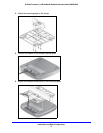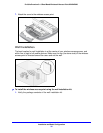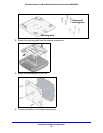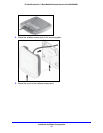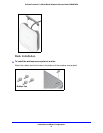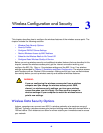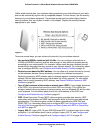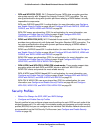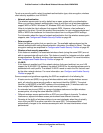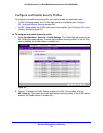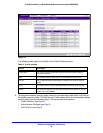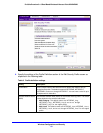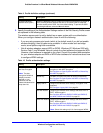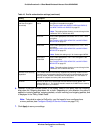
Wireless Configuration and Security
45
ProSafe Premium 3 x 3 Dual-Band Wireless-N Access Point WNDAP620
To set up a security profile, select its network authentication type, data encryption, wireless
client security separation, and VLAN ID:
• Network authentication
The wireless access point is set by default as an open system with no authentication.
W
hen you configure network authentication, bear in mind that not all wireless adapters
support WPA or WPA2. Windows XP, Windows 2000 with Service Pack 3, and Windows
Vista do include the client software that supports WPA. However, client software is
required on the client. Consult the product documentation for your wireless adapter and
WPA or WPA2 client software for instructions about how to configure WPA2 settings.
For information about the types of network authe
ntication that the wireless access point
supports, see Configure and Enable Security Profiles on
page 48.
• Dat
a encryption
Select the data encryption that you want to use. The available options depend on the
n
etwork authentication setting described earlier (otherwise, the default is None). The data
encryption settings are explained in Configure and Enable Security Profiles on p
age 48.
• W
ireless client security separation
If this feature is enabled, the associated wireless client
s (using the same SSID) are not
able to communicate with each other. This feature is useful for hotspots and other public
access situations. By default, wireless client separation is disabled. For more information,
see Configure and Enable Security Profiles on p
age 48.
• VLAN ID
If this feature is enabled and if the network devices (hubs and switches) on your LAN
suppo
rt the VLAN (802.1Q) standard, the default VLAN ID for the wireless access point is
associated with each profile. The default VLAN ID needs to match the IDs that are used
by the other network devices. For more information, see Configure and Enable Security
Profiles on p
age 48.
Some concepts and guidelines regarding the SSID a
re explained in the following list:
• A basic service set (BSS) is a group of wireless st
ations and a single wireless access
point, all using the same security profile or service set identifier (BSSID). The actual
identifier in the BSSID is the MAC address of the wireless radio. (A wireless radio can
have multiple MAC addresses, one for each security profile.)
• An
extended service set (ESS) is a group of wireless stations and multiple wireless
access points, all using the same identifier (ESSID).
• Dif
ferent wireless access points within an ESS can use different channels. To reduce
interference, adjacent wireless access points should use different channels.
• Roa
ming is the ability of wireless stations to connect wirelessly when they physically
move from one BSS to another one within the same ESS. The wireless station
automatically changes to the wireless access point with the least interference or best
performance.



